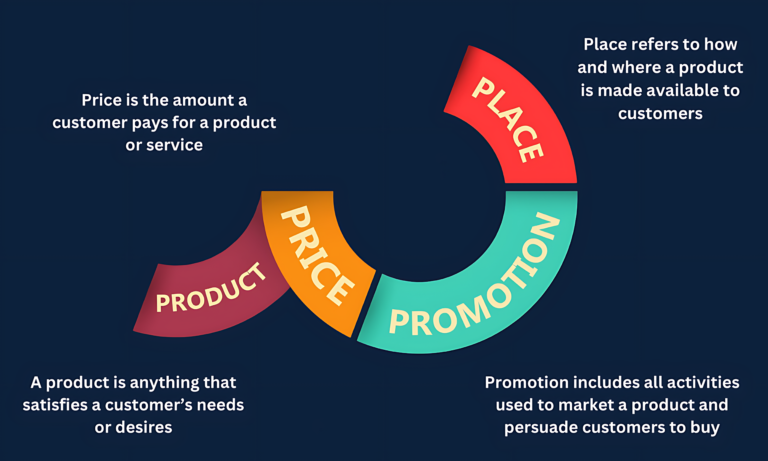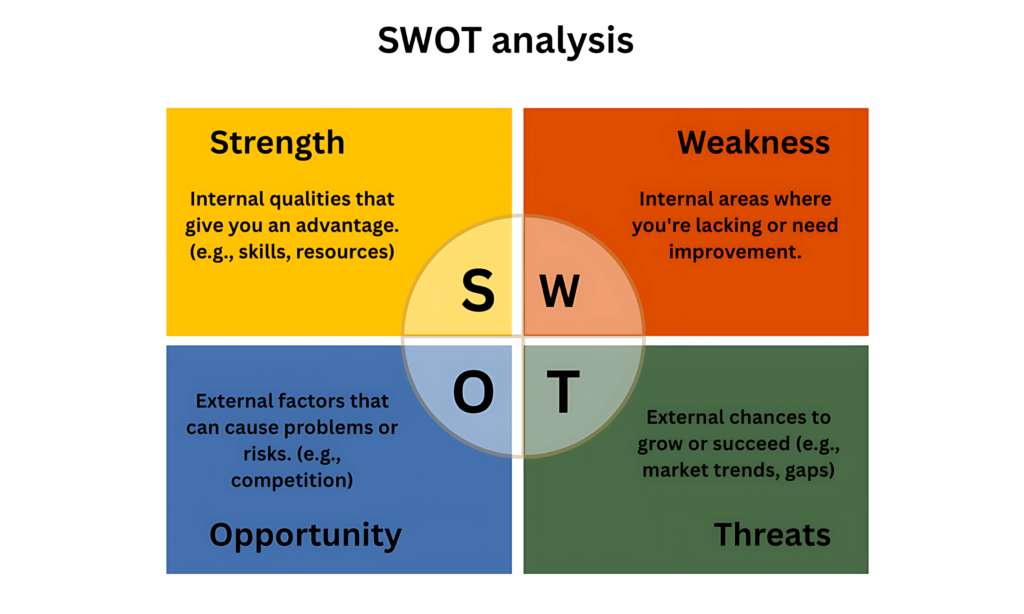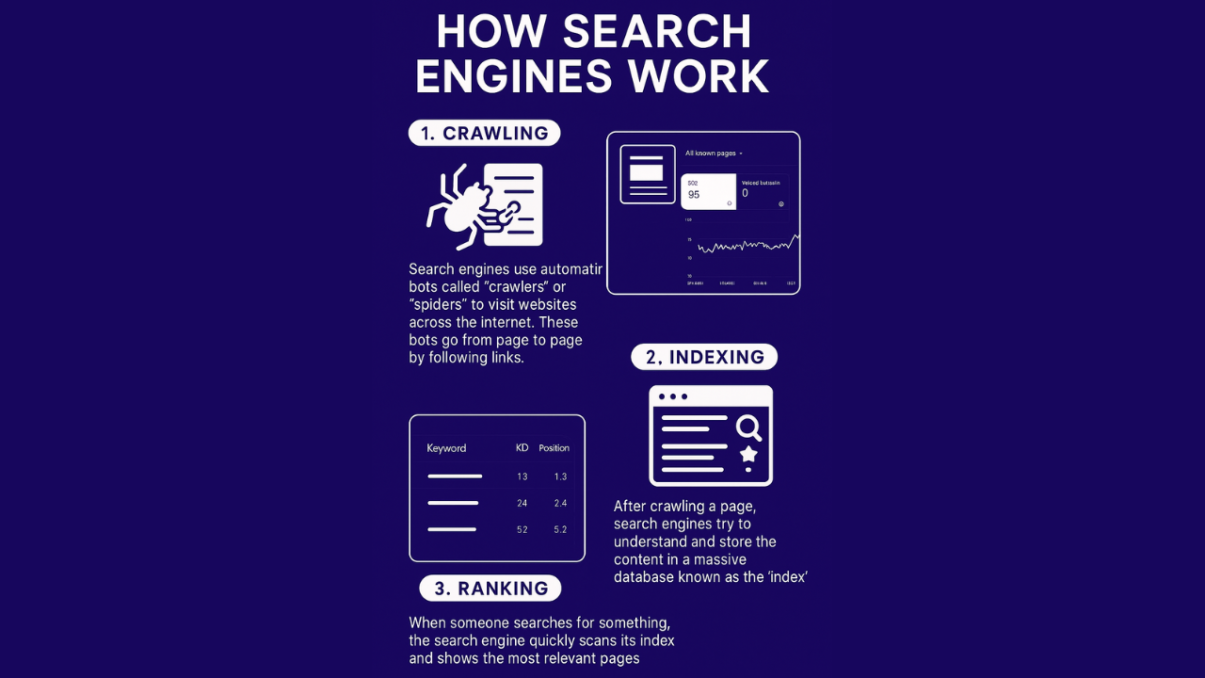If you’re stepping into the world of digital marketing, understanding its core principles is essential. At the center of it all are the 4 Ps of marketing — Product, Price, Place, and Promotion — the timeless framework that shapes every effective marketing strategy. But beyond these pillars, you might ask: What is the fundamental purpose of marketing? Or what is the most important outcome of a company’s marketing strategy? The answer goes deeper than just making sales — it’s about building meaningful connections, delivering value, and driving sustainable growth. In this guide, we’ll explore the fundamentals of digital marketing, uncover its true goals, and help you build a strong foundation for success in today’s digital-first world.
Table of Contents
Togglewhat is marketing ?
Marketing is the process of promoting and selling products or services to meet customer needs. It involves understanding your audience, creating value, and communicating that value effectively to generate sales. Good marketing connects businesses with customers by addressing their needs and desires.
what is the fundamental goal of markting ?
Marketing is the backbone of any business. It helps attract customers, build brand awareness, and increase revenue. Without marketing, even the best products can fail to reach their audience. Companies like Coca-Cola have used marketing to build strong emotional connections with customers over time. For example, Apple creates hype around its new product launches through strategic marketing campaigns, ensuring that customers eagerly anticipate every new release.
Marketing Concepts :
Marketing is more than just advertisements and sales—it’s the strategic process of understanding customer needs, creating value, and delivering that value effectively. in this process, marketers face many challenges. Some of the most common ones include confused minds — when customers don’t really know what they want. According to psychology, a confused mind doesn’t buy, so it needs to be taken care of. Another major challenge is competition — there is too much availability of the same product. While there are many challenges in marketing, these two are among the most common. To deal with them, marketers use certain tools and concepts, one of the most powerful being the 4 Ps of marketing. Over time, marketers have developed key frameworks and models to simplify marketing strategies. Concepts like the 4 Ps of Marketing, 5 Cs of Marketing, AIDA Model, and SWOT Analysis help businesses analyze markets, position their products, and craft compelling campaigns.Let’s take a look.
what are the 4Ps of marketing ?
The concept of the 4 Ps of marketing—Product, Price, Place, and Promotion—was introduced by E. Jerome McCarthy in 1960.

Product
A product can be anything that’s offered to satisfy a customer’s need or want — a physical item, a service, an app, a course, or even an experience.
Product development is the process of creating and improving products, and it often depends on the type of innovation:
Radical innovation, like Apple’s iPhone, introduces something completely new.
Incremental innovation, like Coca-Cola’s new flavors, involves small, ongoing improvements.
Brand management is about how your product is perceived over time. A well-managed brand builds trust, creates emotional connections, and helps your product stand out. For example, Nike represents performance and innovation, while Dove stands for real beauty and care.
What’s Changing in Product Strategy Today?
We’re shifting from firm-created products and brands to co-created ones — where customers actively participate in shaping products, features, or brand identity. Example: LEGO Ideas – fans submit product ideas, vote on them, and winning concepts get turned into actual LEGO sets. It’s a powerful blend of community and creativity.
Modern products are also becoming Customer-centric (shaped by real feedback and behavior), Experience-driven (packaging, design, and ease of use matter more than ever), Sustainable & ethical (buyers care about purpose, not just price),Digital-first( even physical products now come with tech-driven features)
Price
Price is the amount a customer pays for your product or service. It reflects not just cost and profit, but also brand value, positioning, and perceived worth in the customer’s mind.
Pricing plays a major role in customer decisions — it can attract, repel, or position your product as premium or budget-friendly. It’s more than just numbers; it’s about how you want to be perceived in the market.There are several strategies businesses use to set prices. Cost-based pricing focuses on covering production costs with a profit margin. Competitive pricing looks at what rivals are charging, while value-based pricing is determined by how much customers are willing to pay for the perceived value. Some businesses use penetration pricing to enter or disrupt markets by offering lower prices, whereas others use premium pricing to position themselves as high-end or exclusive.
What’s Changing in Pricing Today?
Pricing is becoming more dynamic, with real-time changes based on demand or customer behavior, like Uber’s surge pricing. It’s also more personalized, as AI and data help tailor offers and discounts. Transparency is crucial now, with customers expecting clear, upfront prices without hidden fees. Additionally, flexibility is growing, with brands offering subscriptions, EMIs, and pay-as-you-go options to meet diverse customer needs.
Place
Place is all about making your product conveniently accessible to potential customers.
It’s about making your product available at the right location, at the right time, and through the right channels. Traditionally, this meant physical stores or retail outlets. Today, with the rise of e-commerce, social commerce, and digital marketplaces, businesses are exploring multiple online and offline channels to stay accessible. The focus has shifted from just having a presence to omnichannel strategies—ensuring a smooth, connected experience whether the customer shops online, on mobile, or in-store.
What’s Changing in Place?
Today, the definition of “place” is expanding beyond physical or digital spaces—it’s about creating seamless, integrated experiences. We’ve shifted from isolated channels to omnichannel ecosystems, where customers can switch between online and offline with ease. Speed, convenience, and customer control now dominate. With rising expectations for same-day delivery, real-time updates, and self-service options, businesses are investing in smarter logistics, local warehouses, and interactive storefronts. Even digital-first brands are setting up physical experience centers to build deeper trust and engagement.
Promotion
What’s Changing?
Marketing is moving from selling products to telling stories.
Want to Master the 4Ps of Marketing in Real Life?
Dive deeper into pricing models, expert strategies, and real-world applications.
Join my upcoming mini course to go beyond the basics and learn how to apply the 4Ps effectively with practical examples, expert insights, and case studies.
Click HereSWOT analysis

SWOT Analysis is a simple yet powerful tool that helps businesses analyze their Strengths, Weaknesses, Opportunities, and Threats. It gives a clear picture of where your brand stands and what strategies you should focus on.
Here’s what each part means:
Strengths – What are you good at? What makes your brand/product better than others?
Example: Strong brand image, loyal customer base, unique features.Weaknesses – What’s holding you back? What areas need improvement?
Example: Poor online presence, limited product variety, high costs.Opportunities – What trends or changes can you take advantage of?
Example: Growing demand in your niche, new tech, emerging markets.Threats – What external challenges could impact your success?
Example: New competitors, changing regulations, market saturation
5 Cs of marketing

The 5 C’s of Marketing is a strategic framework introduced by Philip Kotler, widely regarded as the Father of Modern Marketing, during the late 20th century.The 5 C’s stand for Customer, Company, Competitors, Collaborators, and Context (or Climate).lets take a look.
1. Customer
This includes your target audience, current audience, customer feedback, market signals, and rate of audience growth. Understanding who you’re serving and how they behave helps you create better content, products, and campaigns that match their needs and interests.
2. Company
Know your own business well—what your product or service is, what makes it unique (USPs), and how your business operates. When you’re clear about your own strengths and goals, you can confidently plan your marketing strategies.
3. Collaborators
Collaborators are the people and partners who support your business, such as investors, stakeholders, delivery partners, team members, or SEO service providers. Good collaboration helps your business run smoothly and reach more people.
4. Context (Climate)
This is about the outside world and how it affects your business. It includes government rules, social and cultural trends, and emerging technologies. Being aware of these changes helps you adapt and stay ahead in your marketing efforts.
5. Competitors
Competitors can be direct or indirect. Study their strategies, successful campaigns, and challenges. You can also do a simple SWOT analysis of their brand to see where you can stand out or improve your own approach.
Marketing vs sales

Marketing
Marketing is the process of making people aware of your product or service. It includes activities like lead generation campaigns, content creation, SEO, and advertising. The main goal is to generate leads for the sales team and build interest. It creates indirect revenue by attracting potential customers and focuses on highlighting the benefits of a product or service to the audience.
Sales
Sales is the next step, where the team works on converting those leads into paying customers. It’s a direct interaction where reps address customer needs, handle objections, and close deals. This process creates direct revenue and focuses on building relationships with customers. While marketing draws people in, sales helps them take action.
We’ve covered a lot here, and while it might feel like too much at once, don’t worry — this is just the beginning. I tried to keep things simple yet complete, so you don’t have to face the same confusion I did as a beginner. Everyone’s learning journey is different, and this is mine shared with you.
In the next blog, we’ll explore the Fundamentals of Digital Marketing to build a strong base. You’re doing great — one step at a time!




